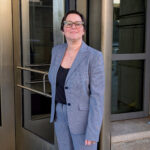By: Carissa Solomon
I have always hated getting things wrong. As a student, I aimed to get everything correct on the first try—after all, that was how school had trained me to think. It wasn’t until I became a teacher that I realized how destructive that fixed mindset is to the learning process. Unfortunately, I had no idea how to help my students develop a growth mindset. I tried all kinds of strategies, but, spoiler alert, none of them worked. Then, a colleague introduced me to a game-changing practice: reflection (thanks, Brian Hyosaka). Regular reflection helps students embrace mistakes as part of learning and recognize that reflecting on past experiences can improve future outcomes.
5 Whys
This reflective practice is based entirely on the power of why. To work best, a Five Whys reflection requires at least two people. One person starts with a statement they believe. This could sound like “I’m bad at math” or “I failed this test because I’m stupid.” Then, their partner asks them “why” questions to help them uncover the root causes behind their initial statement. This practice helps students disrupt false narratives that they, or more likely others, have written about them.
A Five Whys conversation might sound like this:
Student A: The only part of school I like is gym.
Student B: Why do you like gym?
Student A: I have fun in gym.
Student B: Why is it important to have fun at school?
Student A: Knowing I’ll have fun makes me want to come to school more.
Student B: OK. Why is gym fun?
Student A: I get to choose the sport or game I play.
Student B: Why do you like getting to choose?
Student A: I’m more motivated when I’m doing something I picked.
Student B: Why are you more motivated?
Student A: I can choose based on how I feel that day. Like if I’ve got a lot of energy, I might play basketball, but if I’m tired, I might just walk around the track.
This process helps students identify underlying factors like study habits or motivation and see opportunities for growth. The student in the example above discovered that having agency or choice over their activities is important to them, having fun helps them focus, and having something to look forward to during the day motivates them to come to school.
That student is now better equipped to advocate for their needs at school. So now, instead of complaining that gym is the only good part of their day, they can talk to their teachers about the learning conditions that best support them. Can every class be exactly like gym? No. Can every class find a way to provide opportunities for student agency or fun? Absolutely!
This strategy is particularly effective for adolescents, who are prone to embracing extreme or all-or-nothing beliefs. If someone says something mean to them, they think, “Everybody hates me!” Or, if they get the first practice problem wrong in class, they throw up their hands and say, “I can’t do this!” Engaging in a Five Whys reflection can break these patterns by uncovering the factors behind such beliefs.
Start, Stop, Continue
In some situations, you may want students to reflect on an experience, event, or practice rather than a strongly held belief. A Start, Stop, Continue reflection is a perfect fit for such times. Imagine you just returned your students’ first essay of the year. Rather than allowing them to look at their grade and then shove their work into the black hole of their backpacks, have them reflect on their essay-writing experience. The Start, Stop, Continue structure helps students reflect more deeply by organizing their ideas into three easy-to-understand categories.
● Start: What new actions, behaviors, or mindsets could you start to help improve in the future?
● Stop: What actions, behaviors, or mindsets should you stop because they haven’t led to success in the past?
● Continue: What actions, behaviors, or mindsets have served you well and should be continued in the future?
This helps students plan for future growth. Better still, it forces them to identify positive aspects of their past behavior and areas to improve so that no one gets trapped in a cycle of negative self-talk. I particularly enjoy having students collaborate on Start, Stop, Continue reflections, as doing so allows them to learn from their peers’ experiences, too.
Here’s an example of a Start, Stop, Continue reflection completed by a seventh grader on his collaborative practices during a recent group project.
Start: “I will start to develop my leadership abilities. This means I will help my teammates when needed and let them do it independently when they can.”
Stop: “I will stop trying to do my pieces of the project independently, without input or feedback from my teammates. Even when we have assigned roles, it’s important to work together.”
Continue: “I will continue to have a ‘yes and’ mindset when giving feedback to my teammates on their work. I will continue to remember that I cannot control the work that others produce, but I can help create a space where their best work can happen.”
This reflective practice can be used in two ways: to have students reflect on their practices and behaviors for future growth and to gather feedback on instructional practices or school policies. I’ve gained valuable insights by asking students to complete Start, Stop, Continue reflections on various topics, from homework to choice reading to our school’s lunch policy. The structured format helps students feel comfortable sharing honest input, knowing their reflections are taken seriously. While not every suggestion can be implemented, students see enough of their ideas put into action to trust that their opinions matter.
The Power of Regular Reflection
Regular reflection helps students develop the skills to productively analyze their experiences and plan for future growth, fostering a growth mindset. They learn that even perceived failures offer valuable lessons, often leading to the greatest growth. A strong reflective practice also encourages students to take ownership of their successes and challenges. By uncovering the root causes of their experiences, they move from blaming external factors to understanding their role in outcomes. Instead of saying, “The teacher gave me a C! Can you believe it?” they start thinking, “To do better next time, I must attend the optional study sessions.” Reflection transforms learning into a dynamic process that helps students grow far beyond the classroom.
This blog was originally published by Edutopia.
Carissa Solomon is the senior lead educator at Embark Education, an innovative middle school in Denver. In this role, she is pivotal in advancing new ideas and designing and implementing groundbreaking learner-centered practices.
The post Fostering Positive Mindsets Through Reflection appeared first on Getting Smart.
By: Carissa Solomon I have always hated getting things wrong. As a student, I aimed to get everything correct on the first try—after all, that was how school had trained me to think. It wasn’t until I became a teacher that I realized how destructive that fixed mindset is to the learning process. Unfortunately, I
The post Fostering Positive Mindsets Through Reflection appeared first on Getting Smart. SEL & Mindset, mindset, Social-Emotional Learning, student voice Getting Smart






